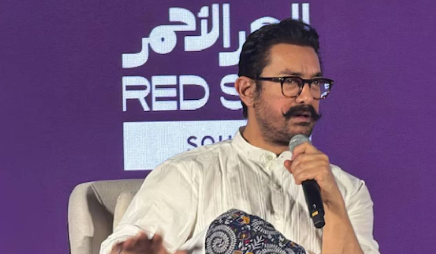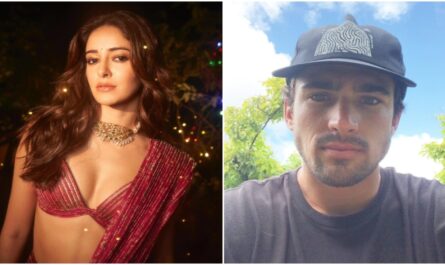In Bollywood’s cinematic history, certain decisions regarding casting and evolution of narratives have prominently influenced the industry’s landscape. One such interesting episode involves the 3 Idiot’s star, Amir Khan’s early association to a script that eventually transformed into the famous film ‘Lage Raho Munna Bhai.’
The actor recently spoke at a press conference for PVR-INOX’s ‘Amir Khan: Cinema Ka Jadugar,’ where he shared the story about the origins of Lage Raho Munna Bhai. A veteran lyricist-screenwriter Javed Akhtar, who was also a part of the event, re-told the interesting story of Bollywood’s history. This perspective, other than shedding light on the film’s developmental journey, also highlights the dynamic nature of storytelling in cinema.
The Genesis of a Unique Script
In the early 2000s, director Rajkumar Hirani has reached out to Amir Khan with an unconventional script idea, as narrated by Khan himself. The actual concept of the film revolved around a young freedom fighter slipping into coma as a consequence of lathi charge. The freedom fighter awakens from coma after 40-45 years later in a changed and revolutionized India. Being unaware of Mahatama Gandhi’s passing, the protagonist commonly converses with the leader therefore realizing how the nation has evolved.
The Script’s Evolution into Lage Raho Munna Bhai
With the script undergoing development, significant changes emerged. The actual storyline which did not feature the interesting character of Munna Bhai, then evolved to include this iconic persona. The story then transformed into what the audience currently recognizes as Lage Raho Munna Bhai.
The Dhoom 3 actor stated that the script he was offered in the beginning, had changed. However, he had no regrets when it came to the story’s evolution.
Amir Khan’s Point of View on the Transformation
Khan agreed that the changed and transformation that the story underwent was definitely in its best interest. Although his initial involvement in the film did not materialize, this perspective highlights his understanding of the fluid nature of storytelling in cinema. It also underlines the collaborative yet ever-evolving nature method of film-making. This shows that narratives might adapt and transform but they can lead to successful outcomes even if they are not expected.
The Impact of Lage Raho Munna Bhai on Indian Cinema
Lage Raho Munna Bhai was released in 2006. The film left its mark on Indian Cinema. The movie was directed by Rajkumar Hirani and it was a sequel to 2003’s hit ‘Munna Bhai M.B.B.S.’ However, despite being the second part of Munna Bhai MBBS and casting the same lead characters as the original film, this one took a completely different narrative.
Although the first film was more focused on the medical profession and strongly emphasized on human compassion, Lage Raho Munna Bhai was based on the concept of Gandhigiri, a modern take on the teachings of Mahatma Gandhi. The film, on top of being very entertaining for the audience, played a potent role in reviving Gandhi’s philosophies in the present India. Moreover, the movie also had an element of humor in it which made it even more interesting for the viewers.
Promoting ‘Gandhigiri’ in Mainstream Culture
Gandhigiri is a term that was derived basically from the Gandhi’s principles. It basically revolved around the use of patience and kindness to tackle injustices existing within the society rather than violence. Sanjay Dutt’s character can be seen conversing with Gandhi (played by Dilip Prabhavalkar) and he learns to take a non-violent strategy when tackling the modern-day problems.
After the film, people started using ‘Gandhigiri’ to indicate peaceful protests and resistance.
Revolutionizing Social Message Films
Lage Raho Munna Bhai was one of its kind and is very popularly known to have set a benchmark for how to mix a strong message while keeping the element of entertainment intact. Before this specific movie, the conventional belief was that movies that had a social message should always be serious or dramatic. However, Lage Raho Munna Bhai completely changed this narrative by using humor as a way to effectively convey an important message.
The film was a major success and it further became the motivation for movies such as Taare Zameen Parr, 3 Idiots and PK in 2014. All of the mentioned movies had a similar theme.
Aamir Khan: The Superstar of Bollywood
Aamir Khan is among the most influential actors till date in the Indian cinema. Khan is known for his though-provoking film choices. He very commonly went with some of the most complicated roles and executed them with utmost perfection earning him the title of ‘versatile.’ Other than acting in India’s biggest blockbusters, the star has also played a prominent role in transforming the industry’s narrative style along with storytelling approach.
Versatile Filmography and Evolution of Career
Aamir Khan’s character choices have strongly indicated that he likes playing challenging roles and pushing boundaries. From being a part of romantic films in the start of his career to experimental and socially relevant movies in the 2000s, one word that describes his career trajectory is ‘versatile.’
In the 1990s, Khan was a part of films like Dil, Jo Jeeta Wohi Sikandar, Rangeela and Raja Hindustani. In 2001, the actor did Lagaan, which was a movie he also produced. The film was nominated for an Academy Award in the ‘Best Foreign Language Film’ category. This was a significant milestone on the global film stage.
Other than being a part of very successful films such as Dil Chahta Hai, Rang De Basanti, and Taare Zameen Par, Khan’s reputation as an actor solidified even more when he opted for 3 Idiots in 2009. The movie became one of Bollywood’s biggest blockbusters.
Social Impact and Thought Leadership
Other than acting, Aamir Khan is also a strong advocate of social change and he has been quite vocal about it. In 2012-2014, Khan had a television show named Satyamev Jayate where social issues such as honor killings, child abuse and female feticide were discussed. He used his influence and platform to raise voice on such topics and the policy changes made him more than just a loved actor – he became a social thought leader with people loving him for reasons more than his acting.



